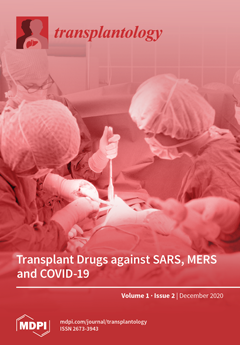Although the donation rate for deceased and living kidneys has been increasing, the donor organ availability meets only the 30% of kidney needs in Italy. Consequently, hemodialysis patients stay for a long time, an average of 3.2 years, on a waiting list for
[...] Read more.
Although the donation rate for deceased and living kidneys has been increasing, the donor organ availability meets only the 30% of kidney needs in Italy. Consequently, hemodialysis patients stay for a long time, an average of 3.2 years, on a waiting list for a kidney transplant with consequent relevant psychological distress or even full-fledged psychiatric disorders, as diagnosed with traditional psychiatric nosological systems. Recent studies report, however, a higher prevalence of other psychosocial syndromes, as diagnosed by using the Diagnostic Criteria for Psychosomatic Research (DCPR) in medically ill and kidney transplant patients. Nevertheless, no data regarding DCPR prevalence are available in patients waitlisted for a renal transplant (WKTs). Thus, the primary aim of this study was to identify sub-threshold or undetected syndromes by using the DCPR and, secondly, to analyze its relationship with physical and psychological symptoms and daily-life problems in WKTs. A total of 30 consecutive WKTs were assessed using the DCPR Interview and the MINI International Neuropsychiatric Interview 6.0. The Edmonton Symptom Assessment System (ESAS) and the Canadian Problem Checklist were used to assess physical and psychological distress symptoms and daily-life problems. A total of 60% of patients met the criteria for at least one DCPR diagnosis; of them, 20% received one DCPR diagnosis (DCPR = 1), and 40% more than one (DCPR > 1), especially the irritability cluster (46.7%), Abnormal Illness Behavior (AIB) cluster (23.3%) and somatization cluster (23.3%). Fifteen patients met the criteria for an ICD diagnosis. Among patients without an ICD-10 diagnosis, 77.8% had at least one DCPR syndrome (
p < 0.05). Higher scores on ESAS symptoms (i.e., tiredness, nausea, depression, anxiety, feeling of a lack of well-being and distress), ESAS-Physical, ESAS-Psychological, and ESAS-Total were found among DCPR cases than DCPR non-cases. In conclusion, a high prevalence of DCPR diagnoses was found in WKTs, including those who resulted to be ICD-10 non-cases. The joint use of DCPR and other screening tools (e.g., ESAS) should be evaluated in future research as part of a correct psychosocial assessment of WKTs.
Full article




